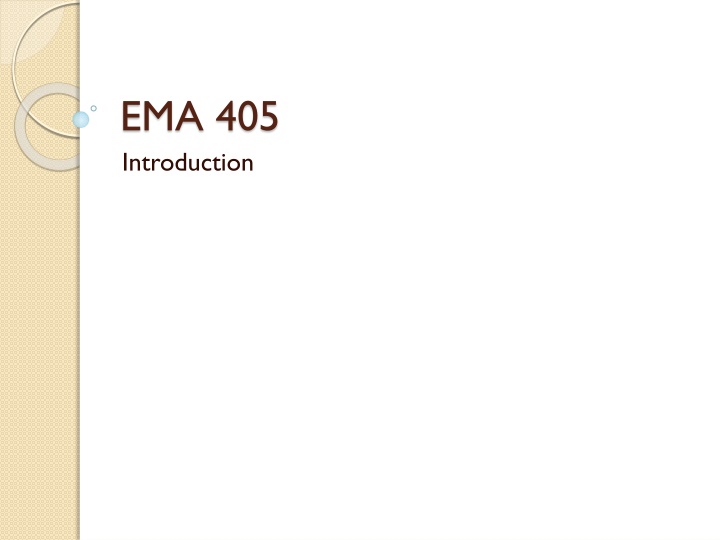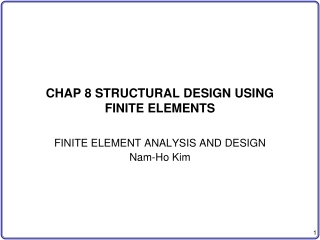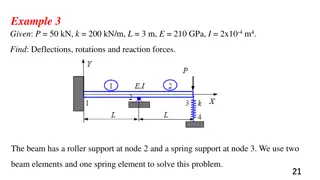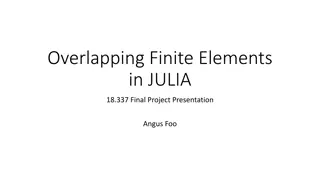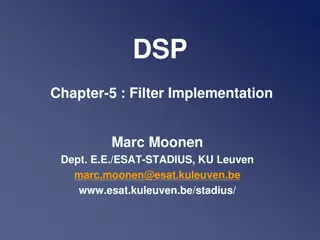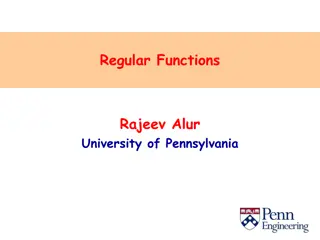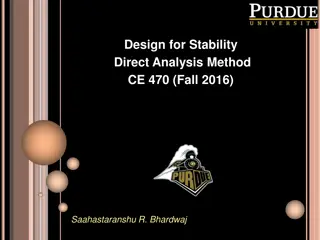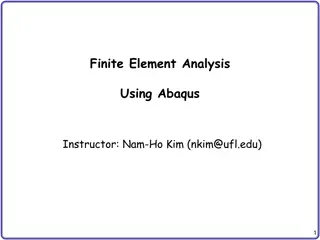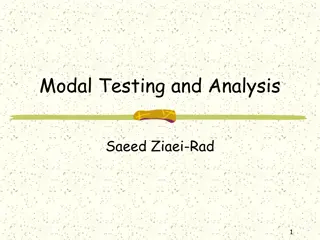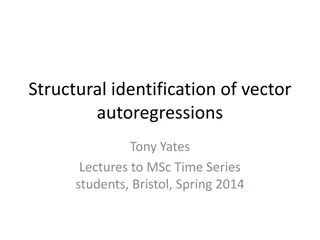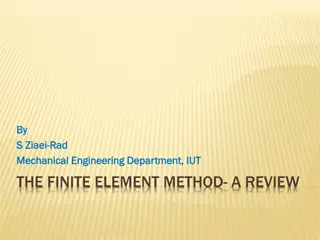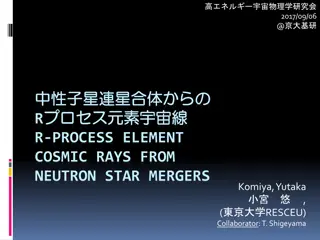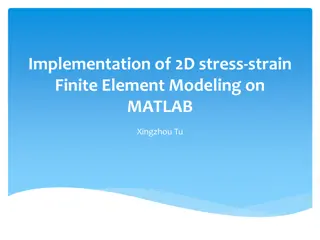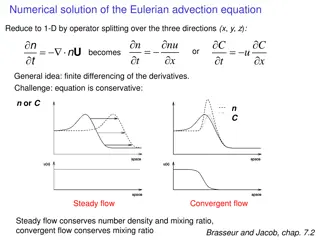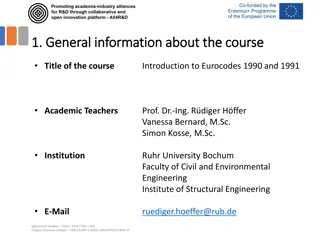Introduction to Finite Element Method for Structural Analysis
This course covers the fundamental concepts of the Finite Element Method (FEM) for solving structural engineering problems. You will explore topics such as FEA theory, ANSYS software, trusses, beams, plates, and more. The course emphasizes practical application through homework assignments, quizzes, a design problem, and a final project.
Download Presentation

Please find below an Image/Link to download the presentation.
The content on the website is provided AS IS for your information and personal use only. It may not be sold, licensed, or shared on other websites without obtaining consent from the author.If you encounter any issues during the download, it is possible that the publisher has removed the file from their server.
You are allowed to download the files provided on this website for personal or commercial use, subject to the condition that they are used lawfully. All files are the property of their respective owners.
The content on the website is provided AS IS for your information and personal use only. It may not be sold, licensed, or shared on other websites without obtaining consent from the author.
E N D
Presentation Transcript
EMA 405 Introduction
Syllabus Textbook: none Prerequisites: EMA 214; 303, 304, or 306; EMA 202 or 221 Room: 2261 Engineering Hall Time: TR 11-12:15 Course Materials: ecow2.engr.wisc.edu
Instructors Jake Blanchard, Room 143 ERB, phone: 263-0391 e-mail: blanchard@engr.wisc.edu office hours: TBD
Grading Homeworks 40% Quiz 20% Design Problem 20% Final Project 20%
Schedule Topics Introduction FEA Theory Intro to ANSYS Trusses Plane Stress/Strain Axisymmetric 3-D Problems Beams Plates Heat Transfer Multiple Load Steps Plasticity
The finite element method Began in 1940 s to help solve problems in elasticity and structures It has evolved to solve nonlinear, thermal, structural, and electromagnetic problems Key commercial codes are ANSYS, ABAQUS, Nastran, etc. We ll use ANSYS, but other codes are as good or better ( a religious question)
The Process Build a model Geometry Material Properties Discretization/mesh Boundary conditions Load Solve Postprocessing
Structural Elements Truss Beams Planar 3-D Plate
Elements Truss Beam Planar Shell Brick
Finite Element Fundamentals The building block of FEM is the element stiffness matrix f u 1 x 1 3 f k k k v 1 y 11 12 16 1 f k k k u a 2 x 21 22 26 2 = k k k f v 2 y 2 1 2 f u 3 x 61 62 66 3 a f v 3 y 3
Now Put Several Together 7 8 9 F = K U 5 4 6 1 3 2
f u 1 x 1 f Global Stiffness v 1 y 1 f u 2 x 2 f v 2 y 2 f u 3 x 3 f [K] is a composite of the element stiffness elements v 3 y 3 f u 4 x 4 f v Once K is known, we can choose forces and calculate displacements, or choose displacements and calculate forces 4 y 4 f u F U 5 x = 5 = f v 5 y 5 f u 6 x 6 f v 6 y 6 f Boundary conditions are needed to allow solution u 7 x 7 f v 7 y 7 f u 8 x 8 f v 8 y 8 f u 9 x 9 f v 9 y 9
Element Stiffness f3y f3x 3 a f2y f1y 1 2 a f1x f2x v3 u3 y v2 v1 x u2 u1
How Do We Get Element Stiffness? u 1 = [ ] u A c assume , ( Rewrite as matrix equation = + + ) 0 a 0 u x y c c x c y u c 1 1 1 2 3 = = + + 1 0 a c ( , ) v x y c c x c y 2 2 4 5 6 1 0 u c 3 3 = A c = = 1 ; 0 = 0 x y u 1 1 Coordinates of element corners = ; 0 x a y 0 0 a 2 2 1 a A 1 = = = 1 1 0 ; 0 x y a 3 3 1 0 1 = = ; u c v c 0 0 c a u 1 1 1 4 1 1 Substitute coordinates into assumed functions 1 a = = + = + 1 1 0 c u ; u c c a v c c a 2 2 2 1 2 2 4 5 1 0 1 c u = + = + ; u c c a v c c a 3 3 3 1 3 3 4 6
Continued au 0 0 c a u 1 1 1 1 ( u ) ) 1 a = + 1 x y u u = Multiply 1 1 0 c u 1 2 a 2 2 ( + u u 1 0 1 c u 1 3 3 3 1 ( ) ( )y c = + + + + ( , ) u x y au u u x u u 1 Rewrite assumed functions 1 1 2 1 3 a u = 1 x y c 2 a c 3 0 0 u 1 1 a u = 1 1 1 0 x y u Substitute 2 1 0 1 u 3
Continued 1 a ( ) = + + ( , ) u x y a x y u xu yu 1 2 3 Collect terms = + + ( , ) u x y N u N u N u 1 1 y 2 2 3 3 x = 1 N 1 a a x = N 2 a y = N 3 a Similarly = + + ( , ) v x y N v N v N v 1 1 2 2 3 3
Stress-Strain x y N u N N = = = + + 1 N 3 1 2 u u u 1 1 2 3 x a a x x x x x u u u = = = + N 1 2 2 x a x a a y v v v = = = + N 3 1 3 y a y a a = + + ( , ) u x y N u N u N u u u v u v v 1 1 2 2 3 v 3 = + = + + 3 1 1 2 = + + xy ( , ) v x y N v N v N y x a a a a 1 1 2 2 3 3
Stress-Strain u 1 v 1 x u B 2 = y v Comes from minimizing total potential energy (variational principles) 2 xy u 3 0 v 3 0 1 1 0 0 0 1 B = 1 0 0 0 1 a 1 1 0 1 1 0 k D B D B tA T T = = B dV B V
Material Properties [D] comes from the stress-strain equations For a linear, elastic, isotropic material x x = [ ] D y y xy xy 1 1 0 E = [ ] 0 D 2 1 2 1 0 0 1 dV D T Strain Energy = U 2 V
Final Result for Our Case ( ( ) ) ( ( ) ) + 3 1 2 1 1 2 + 2 0 0 2 1 3 2 1 1 2 1 2 2 AEt = [ ] k ( 1 ) ( ( ) ) ( ( ) ) 2 2 1 0 1 1 0 2 a 2 2 0 0 1 1 0 1 1 0 2 2 1 = 2 A a 2 ( ( ) ) ( ( ) ) + 3 1 2 1 1 2 + 2 0 0 2 1 3 2 1 1 2 1 2 2 Et = [ ] k ( 1 ) ( ( ) ) ( ( ) ) 2 1 0 1 1 0 4 2 2 0 0 1 1 0 1 1 0 2 2
or ( ( ) ) ( ( ) ) + f 3 1 2 1 1 2 u 1 x 1 + 2 0 0 2 f 1 3 2 1 1 2 v 1 y 1 1 f 2 2 u Et 2 x 2 = ( 1 ) ( ( ) ) ( ( ) ) f 2 1 0 1 1 0 v 4 2 y 2 2 2 0 0 f 1 1 0 1 1 0 u 3 x 3 f 2 2 v 3 y 3
Examples f 3 1 x + f 1 1 y f 2 Et 2 x = u ( 1 ) ( ( ) ) 1 f 2 1 4 2 y f 1 3 x f 2 3 y u1
Examples + f 1 1 x f 3 1 y f 2 Et 2 x = v ( 1 ) ( ( ) ) 1 f 2 1 4 2 y f 1 3 x f 2 3 y v1
Process What do we know? v1=v2=0; f3y=F; all horizontal forces are 0 Remove rigid body motion arbitrarily set u1=0 to remove horizontal translation; hence, f1x is a reaction Reduce matrix to essential elements for calculating unknown displacements cross out rows with unknown reactions and columns with displacements that are 0 Solve for displacements Back-solve for reaction forces
Equations ( ( ) ) ( ( ) ) + 0 3 1 2 1 1 2 f 1 x + 2 0 0 2 0 u 1 3 2 1 1 2 f 1 0 f y 1 2 2 Et 2 = ( 1 ) ( ( ) ) ( ( ) ) 2 0 u 1 0 1 1 0 4 2 0 F y 2 2 0 0 1 1 0 1 1 0 3 or 2 2 v 3 0 2 0 2 u 2 Et = 0 0 F 0 1 0 u ( 1 ) 3 2 4 2 2 v 3
Solution u 2 2 Et F = 0 u 3 1 v 3
Putting 2 Together 3 4 2 a 1 1 2 a
Element 2 Stiffness Matrix 2 (3) 1 (4) 3 Rotate 180o 1 2 3 (2) c s 0 0 0 0 -s c 0 0 0 0 0 0 c s 0 0 0 0 -s c 0 0 0 0 0 0 c s 0 0 0 0 -s c K = TTKT For 180o rotation K =K Just rearrange the rows and columns top correspond to global numbering scheme (in red). T =
Element Matrices ( ( ) ) ( ( ) ) + 3 1 2 1 1 2 0 0 f u 1 x 1 + 2 0 0 2 1 3 2 1 1 2 0 0 f v 1 y 1 1 2 2 0 0 f u 2 x 2 ( ( ) ) ( ( ) ) 1 0 1 1 0 0 0 f Et v 2 y = 2 ( 1 ) 2 2 0 0 2 1 1 0 1 1 0 0 0 f 4 u 3 x 3 f v 2 2 0 0 3 y 3 f u 0 0 0 0 0 0 0 0 4 x 4 f v 0 0 0 0 0 0 0 0 4 4 y 0 0 0 0 0 0 0 0 f u 1 x 1 0 0 0 0 0 0 0 0 f v 1 y 1 ( ) ( ) 0 0 2 2 0 0 1 0 0 1 1 1 f u 2 x 2 0 0 2 2 f Et v 2 y = 2 ( 1 ) 1 2 0 0 0 2 2 0 2 2 f 4 u 3 x 3 ( ) ( ) f v 1 1 0 0 1 0 0 1 1 3 y 3 ( ( ) ) ( ( ) ) f u + 0 0 2 2 3 1 4 x 4 f v + 0 0 1 2 2 1 1 3 4 4 y
Add the element matrices ( ( ) ) ( ( ) ) + 3 1 2 1 1 2 0 0 f u 1 x 1 + 2 3 0 0 1 3 2 1 1 2 0 0 f v 1 y 1 ( ) ( ) 1 0 + 0 2 2 2 1 1 1 f u 2 x 2 ( ( ) ) ( ( ) ) + 1 3 1 f Et v 2 y = 2 ( 1 ) 2 2 + 0 0 1 2 1 1 0 1 3 0 2 2 f 4 u 3 x 3 ( ) ( ) f v + 1 1 3 1 3 y 3 ( ( ) ) ( ( ) ) f u + 0 0 2 2 1 3 1 4 x 4 f v + 0 0 1 2 2 1 1 3 4 4 y
What if triangles have midside nodes? = + + + + + 2 2 ( , ) u x y c c x c y c x c xy c y 1 2 3 4 5 6 c 3 = + + + + + 2 ( , ) v x y c c x c y c x c xy y 2 7 8 9 10 11 12 4 5 2 1 6
What about a quadrilateral element? = + + + ( , ) u x y c c x c y c xy 1 2 3 4 = + + + ( , ) v x y c c x c y c xy 5 6 7 8 3 4 1 2
What about arbitrary shapes? For most problems, the element shapes are arbitrary, material properties are more general, etc. Typical solution is to integrate stiffness solution numerically Typically gaussian quadrature, 4 points k dV D B T V = B
